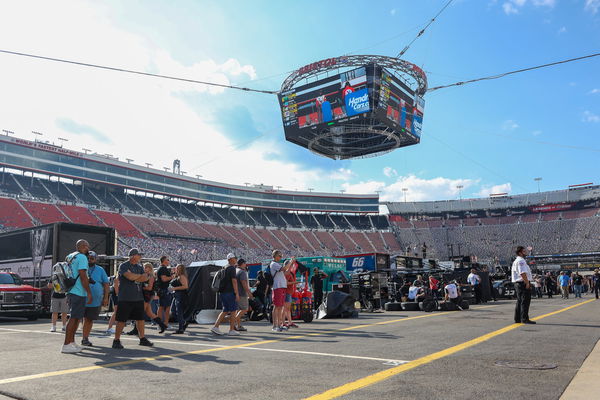
USA Today via Reuters
Sep 15, 2023; Bristol, Tennessee, USA; NASCAR fans watch from the pits during practice for the Bass Pro Shops Night Race at Bristol Motor Speedway. Mandatory Credit: Randy Sartin-USA TODAY Sports

USA Today via Reuters
Sep 15, 2023; Bristol, Tennessee, USA; NASCAR fans watch from the pits during practice for the Bass Pro Shops Night Race at Bristol Motor Speedway. Mandatory Credit: Randy Sartin-USA TODAY Sports
Nothing seems to be going in favor of Stewart-Haas Racing driver Riley Herbst in the Xfinity Series race at Nashville Superspeedway. The driver of the No. 98 Ford had a problem with his radio early in the race and was unable to connect with his spotter. His race car then ran into debris and caught damage on the hood.
Still, he managed to overcome these troubles and started focusing on the race, and this is when another calamity chose to strike him. In the treacherous heat of Nashville, Herbst’s cooling suit failed. This could have been a huge setback for the driver and team if not resolved quickly as the temperature inside the car can go up to 128 degrees. So naturally, this got fans worried about the driver’s health and well-being.
Fortunately, the driver decided to act quickly on the growing issue and headed to the pit road before the end of stage 2. Instead of keeping the heat out and providing a cooling sensation, Herbst’s suit was turning increasingly hot. His pit crew did solve the issue, and from there on, he went to finish the race in 6th place.
ADVERTISEMENT
Article continues below this ad
“On the grid, it was making weird noise. It clunked a little, but I thought, What are we going to do? So we kept going, and I felt hotter and hotter. I made the executive decision to unplug it. That’s risky because you can’t plug it back in. So, that was a 100% decision. Stage 2 was the hardest. That’s when I got a little spotty vision, but cold water in the car and ice got us through.” Herbst said via Frontstretch.
Fans certainly weren’t pleased with NASCAR forcing drivers and teams to race in extreme weather. Not to forget, their directives to ban water coolers certainly haven’t gone down well with the spectators. So when Herbst fell victim to the unfortunate incident, fans lost their cool and questioned the NASCAR safety standards.
LAP 30: The issues for @rileyherbst keep piling up.
First he had radio issues with his spotter.
Then he hit debris.
Now the @StewartHaasRcng driver's cool shirt has failed. #NASCAR | #TNLottery250 | @XfinityRacing
— Seth Eggert (@SethEggert91) June 29, 2024
Nashville heat is riling up the race fans against NASCAR
The cooling suits are designed to help drivers stay cool in extreme temperatures during the race. There are tubes sewn into the shirt that circulate a flow of cold water. But, in Herbst’s case, the water turned hot. Ideally, that should not happen, and therefore, taking a jibe at NASCAR for their failure in keeping their inventions safe to use, a fan stated, “We’ve been putting people on the moon since the 60s and have self-driving cars but we still can’t produce a cool shirt that f***ing works”.
ADVERTISEMENT
Article continues below this ad
Usually, drivers are mostly taken to an infield care center after a crash of heavy impact. But, being on the receiving end of burns and extreme temperatures, this fan was sure that the SHR driver’s immediate move after the race would be to have a check-up; “Herbst is definitely going to go to the in-field care center after this”.
Now we all know NASCAR racing isn’t for the faint-hearted. The driver really braved the heat and pain, all to be in contention for the win. However, this fan would’ve taken the easy route if he found himself in a similar situation, “oh yeah i couldn’t be a nascar driver i’d park the car immediately lmao”.
Drawing an interesting parallel with lobsters, a user went on to explain how Herbst must have been feeling inside the race car, with a failed cooling suit; “Riley about to find out how it feels to be a lobster. Basically going to get halfway boiled”.
ADVERTISEMENT
Article continues below this ad
Now we all know NASCAR’s move to ban water coolers has been controversial. And the cooling suit incident further added fuel to the fire for this fan, who urged the supporters to snub the race event and not show up at the venue, “So are you still not allowed to bring a cooler to the track? If so people really need to boycott this place”.
It will be interesting to see how the Cup Series race pans out and if there will be more issues due to extreme weather conditions.
ADVERTISEMENT
ADVERTISEMENT
ADVERTISEMENT
ADVERTISEMENT

